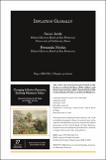Mostrar el registro sencillo del ítem
Inflation globally
| dc.contributor.author | Jorda, Óscar | |
| dc.contributor.author | Nechio, Fernanda | |
| dc.date.accessioned | 2020-09-30T19:43:08Z | |
| dc.date.available | 2020-09-30T19:43:08Z | |
| dc.date.issued | 2020 | |
| dc.identifier.issn | 978-956-7421-67-1 | |
| dc.identifier.issn | 978-956-7421-68-8 (pdf) | |
| dc.identifier.uri | https://hdl.handle.net/20.500.12580/4885 | |
| dc.description | The fortunes of the Phillips curve have ebbed and flowed ever since it was proposed by Phillips (1958). Although its origins are primarily as an empirical regularity, there is now a vast literature that provides more formal justification. In recent times, the Great Moderation and the modern era of central banking brought about the apparent empirical demise of this core relationship. As central banks gained credibility and inflation targeting became widespread, inflation expectations became better anchored; however, the debate is far from settled. Starting in the mid-1980s, several advanced economies have generally experienced the business cycle with barely a ripple in inflation. Paradoxically, a credible, inflation-targeting central bank that cares about the tradeoff spelled by the Phillips curve and sets policy to offset fluctuations in aggregate demand will make empirical estimates of the Phillips curve appear flatter than they really are. The Phillips curve is fundamental for a central bank to evaluate counterfactual policy outcomes. It is not intended to be a forecasting tool. | es_ES |
| dc.description.abstract | The fortunes of the Phillips curve have ebbed and flowed ever since it was proposed by Phillips (1958). Although its origins are primarily as an empirical regularity, there is now a vast literature that provides more formal justification. In recent times, the Great Moderation and the modern era of central banking brought about the apparent empirical demise of this core relationship. As central banks gained credibility and inflation targeting became widespread, inflation expectations became better anchored; however, the debate is far from settled. Starting in the mid-1980s, several advanced economies have generally experienced the business cycle with barely a ripple in inflation. Paradoxically, a credible, inflation-targeting central bank that cares about the tradeoff spelled by the Phillips curve and sets policy to offset fluctuations in aggregate demand will make empirical estimates of the Phillips curve appear flatter than they really are. The Phillips curve is fundamental for a central bank to evaluate counterfactual policy outcomes. It is not intended to be a forecasting tool. | es_ES |
| dc.format | ||
| dc.format.extent | Sección o Parte de un Documento | |
| dc.format.medium | p. 269-316 | |
| dc.language.iso | en | es_ES |
| dc.publisher | Banco Central de Chile | es_ES |
| dc.relation.ispartof | Series on Central Banking Analysis and Economic Policies no. 27 | |
| dc.relation.ispartof | Serie Banca Central, análisis y políticas económicas, no. 27 | |
| dc.rights | Attribution-NonCommercial-NoDerivs 3.0 Chile | * |
| dc.rights.uri | http://creativecommons.org/licenses/by-nc-nd/3.0/cl/ | * |
| dc.subject | INFLACIÓN | es_ES |
| dc.title | Inflation globally | es_ES |
| dc.type.doc | Artículo |


